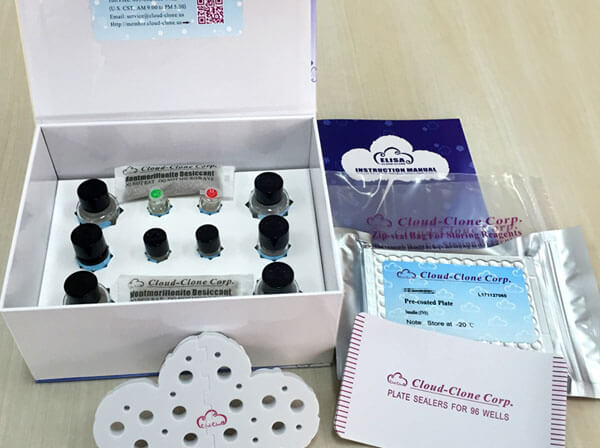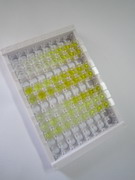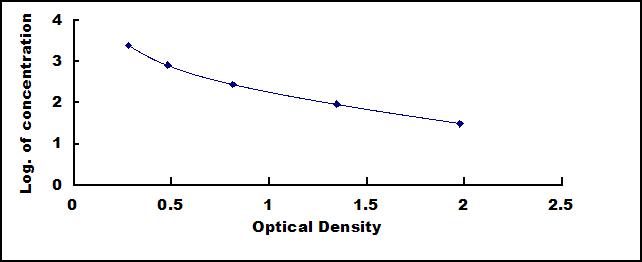ELISA Kit for Dihydrotestosterone (DHT) 

5α-DHT; 5α-Dihydrotestosterone; Androstanolone; Stanolone
- UOM
- FOB US$ 557.00 US$ 796.00 US$ 3,580.00 US$ 6,763.00 US$ 55,692.00
- Quantity
Overview
Properties
- Product No.CEA443Ge
- Organism SpeciesPan-species (General) Same name, Different species.
- ApplicationsEnzyme-linked immunosorbent assay for Antigen Detection.
Research use only - DownloadInstruction Manual
- CategoryEndocrinologyReproductive scienceHormone metabolism
Sign into your account
Share a new citation as an author
Upload your experimental result
Review

Contact us
Please fill in the blank.
Recovery
Matrices listed below were spiked with certain level of Dihydrotestosterone (DHT) and the recovery rates were calculated by comparing the measured value to the expected amount of Dihydrotestosterone (DHT) in samples.
| Matrix | Recovery range (%) | Average(%) |
| serum(n=5) | 79-104 | 101 |
| EDTA plasma(n=5) | 98-105 | 102 |
| heparin plasma(n=5) | 78-99 | 95 |
Precision
Intra-assay Precision (Precision within an assay): 3 samples with low, middle and high level Dihydrotestosterone (DHT) were tested 20 times on one plate, respectively.
Inter-assay Precision (Precision between assays): 3 samples with low, middle and high level Dihydrotestosterone (DHT) were tested on 3 different plates, 8 replicates in each plate.
CV(%) = SD/meanX100
Intra-Assay: CV<10%
Inter-Assay: CV<12%
Linearity
The linearity of the kit was assayed by testing samples spiked with appropriate concentration of Dihydrotestosterone (DHT) and their serial dilutions. The results were demonstrated by the percentage of calculated concentration to the expected.
| Sample | 1:2 | 1:4 | 1:8 | 1:16 |
| serum(n=5) | 83-101% | 98-105% | 95-103% | 78-101% |
| EDTA plasma(n=5) | 82-93% | 98-105% | 98-105% | 93-103% |
| heparin plasma(n=5) | 80-88% | 98-105% | 80-102% | 78-99% |
Stability
The stability of kit is determined by the loss rate of activity. The loss rate of this kit is less than 5% within the expiration date under appropriate storage condition.
To minimize extra influence on the performance, operation procedures and lab conditions, especially room temperature, air humidity, incubator temperature should be strictly controlled. It is also strongly suggested that the whole assay is performed by the same operator from the beginning to the end.
Reagents and materials provided
| Reagents | Quantity | Reagents | Quantity |
| Pre-coated, ready to use 96-well strip plate | 1 | Plate sealer for 96 wells | 4 |
| Standard | 2 | Standard Diluent | 1×20mL |
| Detection Reagent A | 1×120µL | Assay Diluent A | 1×12mL |
| Detection Reagent B | 1×120µL | Assay Diluent B | 1×12mL |
| TMB Substrate | 1×9mL | Stop Solution | 1×6mL |
| Wash Buffer (30 × concentrate) | 1×20mL | Instruction manual | 1 |
Assay procedure summary
1. Prepare all reagents, samples and standards;
2. Add 50µL standard or sample to each well.
And then add 50µL prepared Detection Reagent A immediately.
Shake and mix. Incubate 1 hour at 37°C;
3. Aspirate and wash 3 times;
4. Add 100µL prepared Detection Reagent B. Incubate 30 minutes at 37°C;
5. Aspirate and wash 5 times;
6. Add 90µL Substrate Solution. Incubate 10-20 minutes at 37°C;
7. Add 50µL Stop Solution. Read at 450 nm immediately.

Test principle
This assay employs the competitive inhibition enzyme immunoassay technique. A monoclonal antibody specific to Dihydrotestosterone (DHT) has been pre-coated onto a microplate. A competitive inhibition reaction is launched between biotin labeled Dihydrotestosterone (DHT) and unlabeled Dihydrotestosterone (DHT) (Standards or samples) with the pre-coated antibody specific to Dihydrotestosterone (DHT). After incubation the unbound conjugate is washed off. Next, avidin conjugated to Horseradish Peroxidase (HRP) is added to each microplate well and incubated. The amount of bound HRP conjugate is reverse proportional to the concentration of Dihydrotestosterone (DHT) in the sample. After addition of the substrate solution, the intensity of color developed is reverse proportional to the concentration of Dihydrotestosterone (DHT) in the sample.
Giveaways
Increment services
Citations
- Herbicide Metolachlor Causes Changes in Reproductive Endocrinology of Male Wistar RatsIsrn: 130846
- Metabolic Changes and Hormonal Disturbances in Polycystic Ovarian Syndrome Rats and the Amelioration Effects of Metformin and/or Cinnamon ExtractionJofamericanscience: Source
- Treatment of benign prostatic hyperplasia with Croton membranaceus in an experimental animal modelPubmed:25256687
- Oral administration of low-dose bisphenol A promotes proliferation of ventral prostate and upregulates prostaglandin D2PubMed: 26088557
- Testosterone Replacement Modulates Cardiac Metabolic Remodeling after Myocardial Infarction by Upregulating PPARαpubmed:27413362
- Dihydrotestosterone Treatment Accelerates Autograft Reversal Sciatic Nerve Regeneration in RatsPubmed:29340845
- Uterine progesterone signaling is a target for metformin therapy in polycystic ovary syndromePubmed: 29535146
- Dihydrotestosterone synthesis in the sheep corpus luteum and its potential mechanism in luteal regressionPubmed: 30671954
- Plant cell culture extract of Cirsium eriophorum with skin pore refiner activity by modulating sebum production and inflammatory responsePubmed: 32816329
- Plasma Aromatase Activity Index, Gonadotropins and Estrone Are Associated with Frailty Syndrome in Post-Menopausal Women with Breast CancerPubmed:35323344
- Syce1 and Syce3 regulate testosterone and dihydrotestosterone synthesis via steroidogenic pathways in mouse Sertoli and Leydig cellsPubmed:35697131











